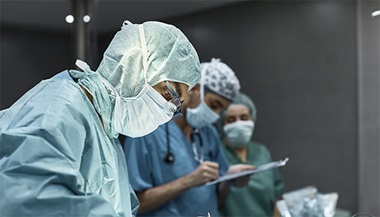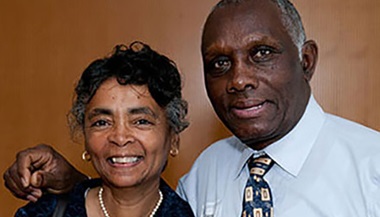Central Line and Central Line Placement
A central line provides access to a person’s blood supply, which allows the patient to receive medications, fluids or additional blood, and allows practitioners to measure or draw blood.
What is a central line?
A central line (central venous catheter) is a long, flexible tube that is similar to an intravenous (IV) line, but it stays in place longer. The tube is inserted into a vein in the neck, chest, arm or groin, and passed through until it reaches a large vein near the heart (the vena cava).
Types of Central Lines
Common types of central lines include:
- A peripherally inserted central catheter (PICC line), which is typically placed in the upper arm or near the elbow
- An implanted port. This type of port is surgically placed into the chest and connected to a catheter that administers medication, draws blood and meets other needs, all occurring under the skin. This type of central line is used for patients needing treatment that will last for months.
- A tunneled central line or catheter. This type of port is surgically placed into a vein in the neck or chest and tunneled under the skin. It exits through the skin in another part of the chest. This is used for patients needing treatment that will last more than two weeks.
- A nontunneled central line or catheter. Similar to a PICC line, the nontunneled central line is placed in the neck, near the collarbone or near the groin. It is used for patients needing treatment that will last less than two weeks.
What is a central line used for?
Central lines have many uses, including:
- Receiving medicines that would damage smaller vessels or veins in the body, such as chemotherapy drugs
- Receiving high-pressure injections (through ports) needed for patients who require chronic red blood cell exchange transfusions, and administering contrast agents needed for computerized tomography (CT) or MRI scans
- For frequent injections, use of IV medicines and blood draws during the course of treatment, resulting in fewer needle sticks (this can be particularly helpful for pediatric patients)
- Administering medications such as antibiotics more quickly during emergencies
Central Line Placement Procedure
Who performs central line placement?
Depending on the type of central line needed, a surgeon or radiologist may place the central line. Interventional radiologists, for example, often place PICC lines, while surgeons often place ports or tunneled catheters.
Before Central Line Placement
Central line placement is a short procedure typically performed in a hospital room, an operating room or an emergency room.
The doctor or surgeon explains the procedure and answers questions. The patient is then placed into position for the procedure, depending on the vein that needs access. The patient will be on their back, either completely flat or at a slight angle so the feet and legs are raised higher than the chest. Vital signs are checked.
Central Line Placement Procedure
- The patient is covered with a large sterile sheet except for the location on the body where the line will be placed. The skin is cleaned with antiseptic solution to lower infection risk.
- A local anesthetic is injected near the vein to numb the skin, making the procedure pain free.
- A catheter is passed into the vein until the tip of the catheter is in the vena cava, close to the heart. An ultrasound machine is usually used to help the surgeon guide the catheter into the vein.
- The other end of the catheter will extend a few inches out from the skin. It may be attached to the skin and held in place with stitches.
- A health care professional flushes the catheter with saline solution, which may include heparin. This prevents blood clots.
- The doctor confirms the catheter’s position with an imaging test, such as an X-ray.
Follow-up Care After Central Line Placement
There will be a period of getting used to the placement, but patients are typically pain free quite quickly.
The follow-up care required after placement and how long the line must remain in place depend on the type of central access performed.
- Ports implanted underneath the skin do not require day-to-day care. However, they need to be flushed (cleaned) once each month.
- Patients with a central line that has external components, like the tunneled catheter, need to avoid getting it wet and must flush the central line every day.
- Those with a central line who develop a fever should immediately call their care team or visit the emergency room for treatment. The care team will take a blood sample and administer IV antibiotics through the central line.
Complications After Central Line Placement
Call a doctor immediately if any of these potential symptoms of infection occur:
- Fever
- Pain in the placement area
- Redness and warming of the skin near placement
- Swelling of the skin near placement
- Discharge from the drainage that is yellow or green
If the central line appears to be getting longer from the entry point, it might be coming out of the vein and will need to be readjusted by a health care professional.
Central Line Placement and Children
When a child has a central line, parents or caregivers often ask if the child can participate in sports or other activities.
After port placement, most children can participate in normal activities. Depending on the type of port, they may need to avoid swimming or high impact/contact sports. Talk to your child’s doctor about activities following central line placement.
For toddlers and babies, there may be concern about them grabbing or pulling at the central line. Items such as vests that cover the line placement can help prevent this from happening. Often, the child’s care team can help identify resources that best meet the child’s needs.






